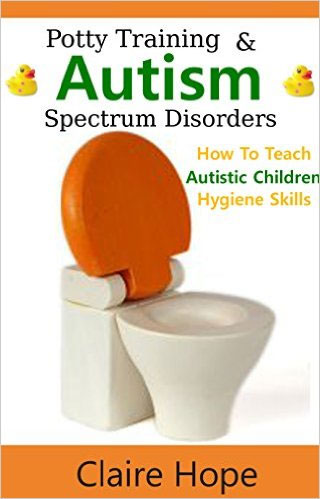
Teaching hygiene to a child is difficult, especially when the child is on the Autism Spectrum. Children often do not see the need for hygiene as germs and bacteria do not make sense to them. Due to oversensitivity, many children on the Autism Spectrum find activities such as showering or using the restroom difficult. How do parents teach Autistic children how to use the restroom and practice proper hygiene? Claire Hope’s book, Potty Training & Autism Spectrum Disorders, How to Teach Autistic Children Hygiene Skills, provides basic tips for teaching Hygiene.
Short But Sweet
One of the greatest features of Claire’s book is its size. It is only 42 pages, easily read within a day. As we are often busy, finding time to read books is difficult for many. Claire’s book quickly dives into the subject matter without any filler or fluff. The goal of the book is to give pointers on how to teach hygiene to autistic children, and this it does. It took me a total of 30 minutes to read the book from start to finish. Given what I learned, it was a worthwhile 30 minutes.
Common Hygiene Problems of Children with Autism
The book opens by discussing the common problems autistic children have maintaining proper hygiene. Many autistic children do not understand the need for good hygiene, as they are often overstimulated or fail to understand social conventions. Most have problems modeling behavior and understanding how to maintain proper hygiene. Also, many have problems following complex tasks, such as potty training, and will refuse or give up.
This section does an excellent job breaking down the difficulties children with autism face regarding hygiene. The book also discusses obsessions over hygiene, which can occur due to OCD tendencies often displayed in Autism. A child can become obsessed over hygiene and over-wash, leading to problems in the future. While this chapter is listed based, it covers most concerns parents with an Autistic child will face.
Potty Training, Baths & Showers
The next two chapters cover how to potty train an autistic child and also to get them to take a bath or shower. These two chapters make the book’s heart and are worth the purchase. Key points include making your child comfortable with the experience, which can be overwhelming for someone with Autism. Those without Autism cannot understand how painful our senses can be. The feel of a washcloth may be painful to someone on the spectrum. The book covers overstimulation and how to get your child to become used to the experience. One simple trick is to take your child into the bathroom a few times daily to get used to the room and do all bathroom-related activities there. This way, they associate using the restroom with these activities, so they know to return to the restroom when needed.
Taking a bath or shower can also be difficult due to the temperature or pressure of the water. Claire recommends creating a daily schedule of activities that are “non-negotiables,” which are activities that must happen. Hygiene is included in this list, as it is important to teach this behavior early. In working with your child, determine what is difficult about the situation. If your child does not want to take a bath, ask yourself if it is the water temperature, the pressure of the water, or the soap or shampoo you are using. Try many different combinations until you find the problem. As children with Autism often have problems communicating, you have to play the role of a scientist in finding out the problem. Also, breaking any activities into steps helps in repeating them. Autistic children often have a problem with complex tasks, which breaking these tasks into steps helps.
Oral & General Hygiene
Getting a child on the spectrum to brush their teeth can be daunting. Claire recommends you model this behavior so they can see it is safe. The feel of the toothbrush can be painful, and the taste of toothpaste can be unpleasant. Have your child touch and feel the toothbrush to become used to the texture. Try different kinds of toothpaste and different toothbrushes until one fits. Oral Hygiene may take some time, but it is worth it.
General hygiene is also covered, including hand washing, stress, and anxiety about hygiene and motivation. Motivation is a significant factor in teaching hygiene, which is why many with Autism have problems with it. Making a game out of these activities will go a long way toward teaching these skills to your child.
In Conclusion
Much more is covered in the book than what is addressed in this review. You can find the book on Amazon, which you can download to your smartphone or tablet. As of this writing, the book costs $5.97. I bought it two years ago when it was on sale for free, so this may happen again in the future. For a book that costs less than $6 and takes only 30-60 minutes to complete, it is worth the purchase. You will learn many techniques for managing potty training and improving hygiene. I recommend this book to anyone who has a child on the spectrum.
Purchase E-Book Format on Amazon
- Autism News Weekly 01-22-2024 - January 24, 2024
- Internet Addiction News Weekly 01-22-24 - January 23, 2024
- Internet Addiction News Weekly 01-18-24 - January 18, 2024








